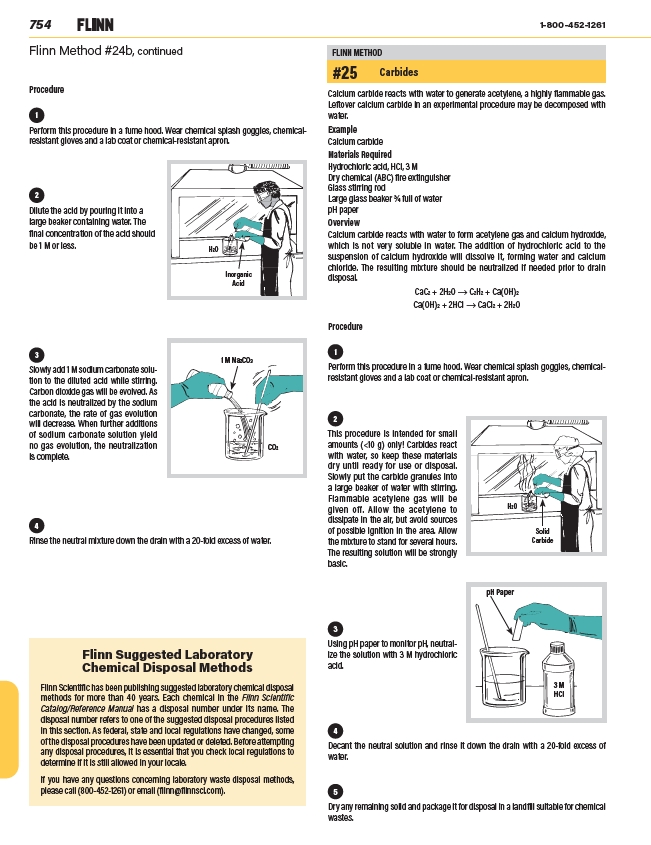
754 1-800-452-1261
Procedure
1
Perform this procedure in a fume hood. Wear chemical splash goggles, chemicalresistant
gloves and a lab coat or chemical-resistant apron.
1
Perform this procedure in a fume hood. Wear chemical splash goggles, chemicalresistant
gloves and a lab coat or chemical-resistant apron.
4
Rinse the neutral mixture down the drain with a 20-fold excess of water.
FLINN METHOD
#25 Carbides
Calcium carbide reacts with water to generate acetylene, a highly flammable gas.
Leftover calcium carbide in an experimental procedure may be decomposed with
water.
Example
Calcium carbide
Materials Required
Hydrochloric acid, HCl, 3 M
Dry chemical (ABC) fire extinguisher
Glass stirring rod
Large glass beaker 3⁄4 full of water
pH paper
Overview
Calcium carbide reacts with water to form acetylene gas and calcium hydroxide,
which is not very soluble in water. The addition of hydrochloric acid to the
suspension of calcium hydroxide will dissolve it, forming water and calcium
chloride. The resulting mixture should be neutralized if needed prior to drain
disposal.
CaC2 + 2H2O → C2H2 + Ca(OH)2
Ca(OH)2 + 2HCl → CaCl2 + 2H2O
Flinn Suggested Laboratory
Chemical Disposal Methods
Flinn Scientific has been publishing suggested laboratory chemical disposal
methods for more than 40 years. Each chemical in the Flinn Scientific
Catalog/Reference Manual has a disposal number under its name. The
disposal number refers to one of the suggested disposal procedures listed
in this section. As federal, state and local regulations have changed, some
of the disposal procedures have been updated or deleted. Before attempting
any disposal procedures, it is essential that you check local regulations to
determine if it is still allowed in your locale.
If you have any questions concerning laboratory waste disposal methods,
please call (800-452-1261) or email (flinn@flinnsci.com).
Procedure
Flinn Method #24b, continued
4
Decant the neutral solution and rinse it down the drain with a 20-fold excess of
water.
5
Dry any remaining solid and package it for disposal in a landfill suitable for chemical
wastes.
2
Dilute the acid by pouring it into a
large beaker containing water. The
final concentration of the acid should
be 1 M or less. H2O
Inorganic
Acid
3
Slowly add 1 M sodium carbonate solution
to the diluted acid while stirring.
Carbon dioxide gas will be evolved. As
the acid is neutralized by the sodium
carbonate, the rate of gas evolution
will decrease. When further additions
of sodium carbonate solution yield
no gas evolution, the neutralization
is complete.
CO2
1 M Na2CO3
2
This procedure is intended for small
amounts (<10 g) only! Carbides
react
with water, so keep these materials
dry until ready for use or disposal.
Slowly put the carbide granules into
a large beaker of water with stirring.
Flammable acetylene gas will be
given off. Allow the acetylene to
dissipate in the air, but avoid sources
of possible ignition in the area. Allow
the mixture to stand for several hours.
The resulting solution will be strongly
basic.
H2O
Solid
Carbide
3
Using pH paper to monitor pH, neutralize
the solution with 3 M hydrochloric
acid.
pH Paper
3 M
HCI